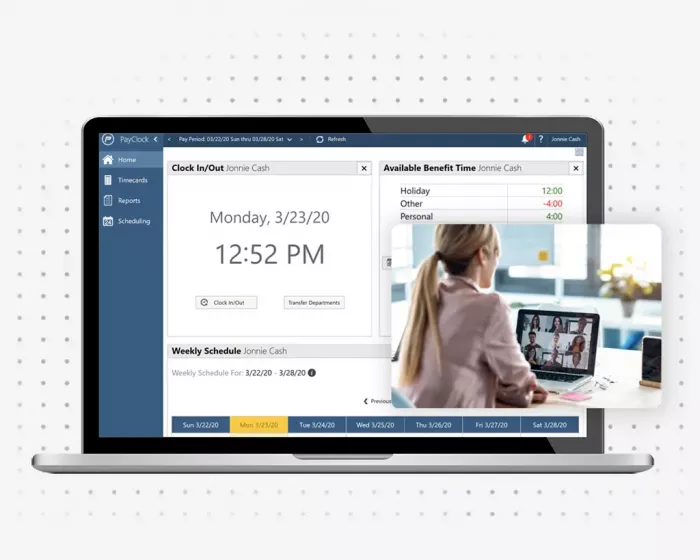On This Page
- Why Time Tracking is Essential for Remote Teams
- The Challenges of Remote Time Tracking
- Benefits of Remote Employee Time Tracking (When Done Right)
- Best Practices for Implementing Time Tracking in Remote Teams
- How to Choose the Right Time Tracking System for Your Remote Team
- Legal and Ethical Considerations
- Cultural Shifts: From Surveillance to Support
- Case Example: How One Company Transformed Time Tracking
- Conclusion: Time Tracking for the Future of Work
In the modern digital workplace, remote work is no longer a perk — it's the norm. As teams spread across cities, countries, and continents, businesses face a growing challenge: how to track time effectively without compromising employee freedom, morale, or privacy.
Time tracking has evolved from a simple punch clock to sophisticated digital platforms that can log hours, monitor tasks, and produce actionable productivity insights. However, when implemented poorly, these systems can feel intrusive or bureaucratic — the opposite of what remote work promises.
So, how do you implement remote employee time tracking that benefits both the business and the employee? This article explores the answer, with strategies, tools, and leadership approaches that align with the future of work.
Why Time Tracking is Essential for Remote Teams

Remote work offers flexibility, but it also introduces blind spots for managers. Without direct visibility into what team members are doing, it becomes harder to gauge progress, allocate resources, and manage workloads.
Time tracking solves several challenges:
- Accountability: Confirms employees are working during expected hours.
- Productivity measurement: Helps teams understand how time is being spent and identify inefficiencies.
- Project management: Enables better time estimation and resource planning.
- Payroll and billing: Essential for paying hourly workers or invoicing clients accurately.
- Compliance: In some industries, businesses must document work hours for legal or regulatory reasons.
Without a structured way to track time, remote operations can quickly become chaotic, with deadlines slipping and burnout rising unnoticed.
The Challenges of Remote Time Tracking
While the need is clear, time tracking in a remote setup isn’t without its challenges.
1. Loss of Trust
Excessive monitoring can create a culture of suspicion. Employees may feel their privacy is being violated or that they’re not trusted to manage their own time.
2. Overhead and Complexity
Manual time entry systems can be cumbersome and time-consuming. When tracking becomes a task in itself, productivity suffers.
3. Cultural Resistance
In some companies, especially those that emphasize creativity or deep work, time tracking can be seen as a relic of old-school management.
4. Micromanagement Risk
If data is used punitively — like obsessing over every idle minute — it undermines morale and motivation.
The solution lies in choosing the right tools, setting the right expectations, and fostering a culture that uses time tracking to support — not control — your team.
Benefits of Remote Employee Time Tracking (When Done Right)
When thoughtfully implemented, time tracking offers several key benefits:
- Improved productivity: Time logs reveal how work hours are being spent, helping employees optimize focus and reduce distractions.
- Better workload management: Managers can see who is overloaded and who has bandwidth, allowing for smarter task distribution.
- Clearer performance metrics: When combined with task completion, time data provides a clearer picture of employee effectiveness.
- Greater transparency: Both managers and employees gain clarity on priorities, progress, and bottlenecks.
- Data-driven decisions: From forecasting to hiring, time data helps inform strategic decisions across the business.
Rather than feeling like surveillance, time tracking becomes a shared tool for growth and clarity.
Best Practices for Implementing Time Tracking in Remote Teams
Here’s how to approach remote time tracking in a way that builds trust and delivers value:
1. Start with Why
Communicate the purpose of time tracking to your team. Emphasize how it supports:
- Fair compensation
- Better planning
- Reduced burnout
- Improved focus
When people understand the "why," they’re far more likely to embrace the "how."
2. Choose Flexible and Transparent Tools
Look for time tracking platforms that offer:
- Automatic or manual time logging
- Task or project-based tracking
- Privacy controls (e.g., break or private mode)
- Optional screenshots (used ethically and with consent)
- User-friendly dashboards and reports
- Integrations with your project management and payroll systems
Avoid overly intrusive tools that log keystrokes, mouse movement, or webcam access — these often do more harm than good.
3. Define What You’re Tracking
Set clear expectations. Are you tracking:
- Total hours worked per day?
- Time spent on specific projects?
- Billable vs. non-billable time?
- Breaks and idle time?
Clarity prevents misunderstandings and creates consistency across the team.
4. Respect Flexibility
Remote work often allows for non-linear schedules. Some team members may be most productive at 6 AM or 10 PM. Focus on results over rigidity.
Let employees structure their day as long as deliverables are met and collaboration windows are honored.
5. Train and Support Your Team
Provide training on how to use the tool — not just technically, but culturally. Help them understand how to:
- Log time accurately
- Review their own performance data
- Use reports to improve focus and planning
Encourage self-awareness, not just compliance. In fact, fostering professional growth through better work habits is a key motivator in many remote teams. Supporting employees with training, time insights, and advancement opportunities leads to long-term success. For those aiming to grow their remote careers further, this guide to top online platforms for professional growth offers valuable insights into upskilling and advancing while working from anywhere.
6. Use Data Responsibly
Data should support coaching and continuous improvement — not criticism. Use reports to:
- Identify patterns of overload or distraction
- Celebrate efficient work habits
- Spot workflow inefficiencies
Hold regular 1-on-1s to discuss what the data shows, and ask employees for input. Empower them to take ownership of their time.
How to Choose the Right Time Tracking System for Your Remote Team
Selecting the right time tracking solution isn't just about comparing features — it’s about choosing a tool that supports your company culture, workflows, and the way your team operates remotely. The best system is the one your team will actually use and trust.
To begin, consider what you want to accomplish with time tracking. Are you primarily tracking hours for client billing, internal productivity, or project estimation? Your goal should shape the software you choose. For example, if you work with external clients and contractors, you might need detailed reporting and invoicing features. If your team works on internal projects, a simpler solution may suffice — one that focuses on transparency and personal productivity rather than strict oversight.
Ease of use is critical. A time tracking tool should integrate seamlessly into your team’s daily routine. If the system is clunky or interrupts workflow, your team will either abandon it or engage with it reluctantly, which defeats the purpose. Choose something intuitive — ideally, with clean design, minimal manual entry, and optional automation.
There are two main types of tracking systems, and understanding the difference can help you choose the right one:
- Manual systems: These allow users to start/stop timers or log time after tasks are completed. They offer flexibility and trust but depend on user discipline.
- Automatic systems: These run in the background, logging app usage, URLs, and activity levels. They reduce the burden of manual input but can raise privacy concerns if not used transparently.
Integration is another important factor. If you already use tools like Asana, Trello, Notion, or Jira, your time tracking software should sync with them. This saves time, reduces duplication, and provides a clearer picture of how tasks and hours connect. Look for platforms that embed time tracking directly into your project boards, allowing employees to log time without switching tools.
Scalability matters too. A time tracking tool that works for a five-person startup might not hold up as you grow to fifty or five hundred employees. Think ahead — can the system handle multiple teams, departments, or clients? Does it allow different access levels for managers and employees? Can it generate both high-level summaries and detailed individual reports?
When evaluating options, prioritize tools that offer:
- An intuitive user interface
- Mobile and desktop accessibility
- Customizable reports and dashboards
- Role-based permissions
- Data privacy controls
- Integration with your payroll or invoicing system
Privacy and legal compliance are non-negotiable. Remote teams often span countries and legal jurisdictions, so any tool you choose must follow data protection laws like the GDPR or CCPA. Always opt for a solution that offers transparent data practices, allows employees to view their own tracked data, and avoids invasive practices like webcam monitoring or stealth tracking.
Before launching a new system across your entire company, consider running a pilot program with a small team. This allows you to see how well the software fits into your day-to-day operations and gives you a chance to adjust internal processes or expectations. Involving your team in the selection and rollout process also increases buy-in and reduces resistance.
Ultimately, the right time tracking system is not just a piece of software — it’s a tool that should reinforce your values, improve transparency, and support your remote team’s ability to work effectively without micromanagement.
Legal and Ethical Considerations
If you’re tracking employee time and activity, you need to be aware of:
- Local labor laws: Different countries have different regulations about employee monitoring.
- Privacy laws (e.g., GDPR): Employees must give informed consent to being tracked, especially if screenshots or activity logs are involved.
- Fair use policies: Don’t use time tracking to punish employees for every idle minute — context matters.
Always document your time tracking policy and include:
- What is tracked and why
- How data is stored and protected
- Who has access to the data
- How employees can dispute or correct their logs
Cultural Shifts: From Surveillance to Support
Traditional time tracking often focused on control. But in 2025, the most forward-thinking companies use it to empower self-management.
Here’s what the shift looks like:
- From clocking in/out to understanding time value
- From monitoring hours to measuring impact
- From checking up to checking in
- From rigidity to responsibility
When employees are trusted with their time — and equipped with the tools to manage it — they become more engaged, focused, and fulfilled.
Case Example: How One Company Transformed Time Tracking
Let’s say a mid-sized software firm with 60 remote employees struggled with missed deadlines and unclear workloads. Initially, they introduced a rigid time tracking app with keystroke logging and webcam screenshots. Within weeks, morale plummeted, and three senior developers quit.
The company realized their mistake. They switched to a more respectful tool (Toggl Track), eliminated screenshots, and focused on tracking project hours instead of minute-by-minute activity. Managers held weekly reviews with their teams to discuss time usage, blockers, and priorities.
The result? Productivity improved. Employees reported feeling more in control of their time. Trust was restored, and deadlines were met more consistently.
Conclusion: Time Tracking for the Future of Work
Remote employee time tracking isn’t going away — it’s evolving. As more teams go digital and distributed, the need for smart, respectful, and transparent tracking systems will only grow.
By focusing on outcomes over oversight, choosing the right tools, and building a culture of shared accountability, you can turn time tracking from a chore into a powerful asset.
Time is your team’s most valuable resource. Treat it with the respect it deserves.
Post Comment
Be the first to post comment!





